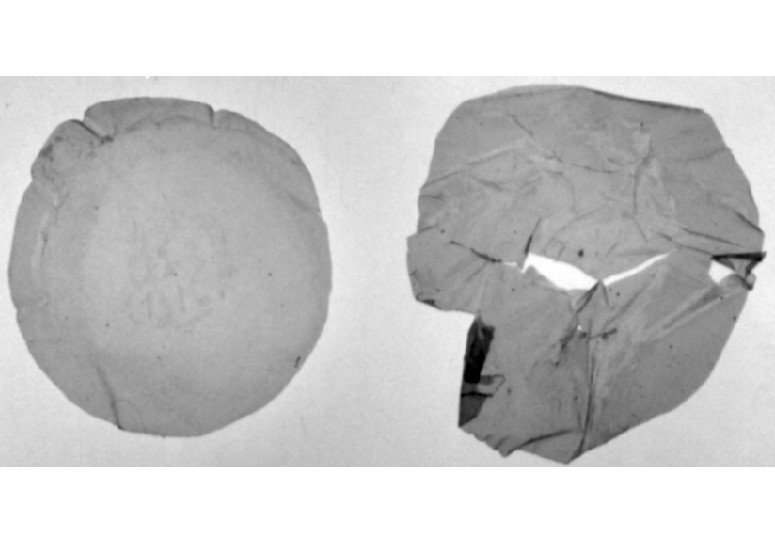


Illustrative image of polyethylene degradation by microorganisms developed by the research group. On the left is control plastic incubated in buffer. On the right is the same plastic after being subjected to the action of microorganisms (image: Fábio Squina/UNISO)
Published on 07/07/2025
By José Tadeu Arantes | Agência FAPESP – A Brazilian study has obtained promising results in using microorganisms to degrade plastics and produce bioplastics. The study has also advanced the understanding of the enzymes and biochemical pathways involved in the process. The details were published in the journal Science of The Total Environment.
In the wake of the climate crisis, plastic pollution has become one of the most pressing environmental issues. Around 350 million tons of plastic become waste every year. Approximately 40% of this total is packaging. These figures come from a study by Credit Suisse; according to the same source, 46% of plastic waste is sent to landfills, 17% is incinerated, and only 15% is recycled.
Not only is recycling quantitatively insignificant, but it is also not a real solution to the problem as it has been practiced. “It doesn’t solve it because it generally produces plastics with inferior properties and applications that will also be discarded at the end of their use,” argues Fábio Squina, a researcher, professor at the University of Sorocaba (UNISO), and coordinator of the study, which involved collaborators from the State University of Campinas (UNICAMP) and the Federal University of ABC (UFABC).
Microbial communities
Using soil contaminated by plastics as samples, the scientists developed microbial communities that can degrade materials such as polyethylene (PE) and polyethylene terephthalate (PET). Metagenomic analysis of these communities identified new microorganisms and enzymes associated with polymer degradation. One highlight was developing a strain of Pseudomonas sp., named BR4, that breaks down PET and produces polyhydroxybutyrate (PHB), a high-quality bioplastic. Enriched with hydroxyvalerate (HV) units, this material is more flexible and resistant than pure PHB and can be used to manufacture sustainable packaging and for biomedical applications.
“To arrive at this and other results, we sequenced the genomes of 80 bacteria present in microbial communities, identifying species already described in the literature and also new ones associated with the degradation of plastic polymers. And we evaluated the genetic potential of each one to encode enzymes involved in polymer degradation,” says Squina.
In addition, the study mapped transporters and metabolic pathways involved in the degradation and assimilation of plastic polymers. “The microbial communities showed remarkable characteristics, degrading polymers based on cooperative interactions between bacteria and specialized biochemical pathways,” the researcher comments.
Supported by FAPESP through 13 projects (15/23279-6, 19/19360-3, 20/11019-8, 21/04254-3, 22/14112-4, 23/04782-5, 23/04828-5, 23/12398-0, 23/04941-6, 23/08832-7, 20/05784-3, 22/05731-2, and 22/08958-8), the research highlighted the potential of omics approaches in microbial communities as a promising platform for discovering enzymes and microorganisms for converting fossil-based plastics into biopolymers. The study also suggests that these platforms can be used with other types of plastics, which would expand the impact of the technology. “We’re exploring ways of biochemically improving enzymes and microorganisms to degrade plastics that are more resistant than PET,” says Squina.
He adds that “as well as producing bioplastics, microorganisms can be used to produce other chemical compounds with applications in agriculture, cosmetics, and the food industry.” However, he points out that more research is needed to validate these findings in real environmental conditions and optimize the performance of the microorganisms.
A study carried out by the United Nations Environment Program (UNEP) showed that plastic accounts for 85% of the waste that reaches the oceans. The report also states that the volume of plastic flowing into the sea is expected to nearly triple by 2040, which threatens all species that depend on the marine environment, including plankton, mollusks, birds, turtles, and mammals. Plastic debris could suffocate corals, mangroves, and seagrass by preventing them from receiving oxygen and light. Another emerging issue is microplastic pollution, which affects soil, water, and air. They insidiously lodge in human organs.
While governments are still doing little to stop and reverse this process, as is also the case with the climate crisis, the scientific community is working to find solutions. The study in question is a contribution to this effort.
The article “Plastic-degrading microbial communities reveal novel microorganisms, pathways, and biocatalysts for polymer degradation and bioplastic production” is available at: www.sciencedirect.com/science/article/abs/pii/S0048969724050253?via%3Dihub.
Source: https://agencia.fapesp.br/55270